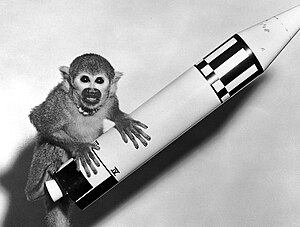
Back حيوانات في الفضاء Arabic Zvířata ve vesmíru Czech Animales en el espacio Spanish جانوران در فضا Persian Animal dans l'espace French חיות בחלל HE Կենդանիները տիեզերքում Armenian 宇宙に行った動物 Japanese Ғарышқа ұшқан жануарлар Kazakh 우주 실험 동물 Korean

| Landmarks for animals in space |
|---|
|
Animals in space originally served to test the survivability of spaceflight, before human spaceflights were attempted. Later, many species were flown to investigate various biological processes and the effects microgravity and space flight might have on them. Bioastronautics is an area of bioengineering research that spans the study and support of life in space. To date, seven national space programs have flown animals into space: the United States, Soviet Union, France, Argentina, China, Japan and Iran.
A wide variety of animals have been launched into space, including monkeys and apes, dogs, cats, tortoises, mice, rats, rabbits, fish, frogs, spiders, insects, and quail eggs (which hatched on Mir in 1990). The US launched the first Earthlings into space, with fruit flies surviving a 1947 flight, followed by primates in 1949. The Soviet space program launched multiple dogs into space, with the first sub-orbital flights in 1951, and first orbital flights in 1957.[1]
Two tortoises and several varieties of plants were the first Earthlings to circle the Moon in September 1968 on the Zond 5 mission. In 1972, five mice nicknamed Fe, Fi, Fo, Fum, and Phooey orbited the Moon a record 75 times aboard command module America as part of the Apollo 17 mission (the most recent to put Earthlings in lunar orbit).
- ^ Berger, Eric (3 November 2017). "The first creature in space was a dog. She died miserably 60 years ago". Ars Technica. Archived from the original on 1 December 2017. Retrieved 3 November 2017.
© MMXXIII Rich X Search. We shall prevail. All rights reserved. Rich X Search